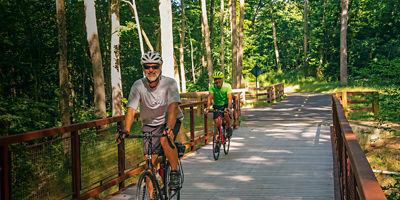
Whether you wore out your tread, keep getting flats, or need every advantage to keep up on the group ride, it might be time to buy new bike tires. Buying a new set of tires is an opportunity to customize your ride to match your style and terrain perfectly. Here’s how to navigate your choices for both road and mountain bikes.
Ask Yourself These Questions
What kind of riding will I be doing?
Road: Determine if you’ll mostly be riding on rough city streets, pristine tarmac, dirt paths, or something in between.
Mountain: Do you like to ride on hard-packed dirt or are you someone who likes getting out in wet and loose conditions?
Do I value speed or comfort?
A cushier ride is possible, but often involves sacrificing speed. You can choose to focus on speed instead, but you’ll likely feel every bump and jitter in the road.
How much do I hate changing flats?
You can prioritize puncture resistance, but that usually means a heavier tire.
Tubes or Tubeless
One of your first considerations will be whether to run tubeless or the more familiar clincher tires.
Clincher
Clincher tires are the type of tires that you are likely most familiar with. Clincher tires use an internal tube to hold air pressure within your tire.
Pros: Innertubes can easily be swapped if you get a flat. They’re easy to install and replace, and are relatively affordable.
Cons: Tubes are vulnerable to getting pinch flats with hard impact. To help prevent this, they often require more pressure than their tubeless counterparts.
Tubeless
Tubeless tires work much like clincher tires, but rather than an innertube helping the tire seal, a liquid sealant fills any gaps between the tire and rim.
Pros: Tubeless tires get fewer flats, since you can’t get a pinch flat when you don’t have an innertube. And you can run tubeless tires at lower pressures, which improves traction and comfort.
Cons: Installation and changing a flat can be complicated, plus you need a compatible rim.
Tubular
Tubular tires are used mostly by the pros. The inflatable tube is sewn directly into the tire itself and then glued into the rim of your wheel. That saves weight, but most riders won’t find it’s worth the cost or hassle.
Pros: They’re lighter than other styles.
Cons: Difficult to change a flat, expensive.
Parts of a Tire
A basic understanding of tire construction will help you navigate the choices.
Bead
The bead is what locks the tire into the rim. Inexpensive tires will have a wire bead while higher-end tires will have a Kevlar bead that is lighter and more flexible.
Casing
The casing is what holds the various layers of the tire together. Casings are measured in threads per inch. A higher TPI will give a better feeling ride but won’t be as durable. A count of around 60 TPI provides good durability, but it will be heavier than higher TPI options.
Sidewall
The sidewall is the part of the tire that extends from the rim up toward the tread. This is where the information about your tire size and appropriate inflation PSI is found.
Tread
This is the part of the tire that touches the ground, and affects both traction and speed.
Additional Puncture Protection
Do you frequently ride on rough terrain? There are a few strategies. Some tires have reinforced sidewalls, kevlar layers, a second ply of the entire casing, or just a second ply under the tread. While these extras improve puncture resistance, they add weight.
Valves
For inflating tires, there are two common types of valves: Presta and Schrader. Your rim will be designed to accommodate one type of valve or the other. You’ll also need the appropriate pump (or an adaptor).
Schrader: This is what your car uses. Schrader valves are easy to use, serviced by almost every pump, and incredibly durable.
Presta: These are narrower than Schrader valves and have a screw top that you have to open before inflating them, and a screw in valve-core that can be removed. They’re better at handling high pressure, and their narrow size makes them popular for skinny road tires. They also have advantages for mountain bikers. The removable valve core makes it possible to refill your tire with sealant if you are running tubeless tires.























